Place Jean-Paul Sartre in Paris
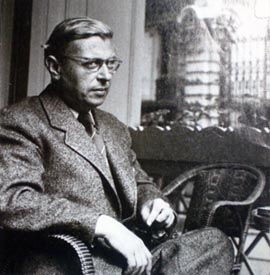
|
In order to answer this question, let us review the events that took place in France during World War II.
-
Paris of 1940. We all know from our French colleagues that French
men and women are mighty proud of their country. However, Parisians had to witness this scene in 1940.
Yet, they knew they could not fight back in France. Thus
many young men fled to England to join the Free French Forces being organized
by General Charles de Galle.
-
Stalingrad in Paris. When Parisians heard of the annihilation
of Hitler's 6th Army in Stalingrad, it was like the second coming of Jesus.
This is the reason why there is a metro station called Stalingrad in Paris.

Image from Wikipedia. - In Nice (southern Mediterranean city), where German influence was relatively
weak, French artists resisted German invasion in their own way. I wonder
whether you have seen a French film entitled
Les Enfants
du Paradis or Children of Paradise. It is based on a traditional
French love story.
The point is its logistics. It takes more than a camera to make movies. It requires money, manpower, engineering, set-ups, and cooperation from authorities. I do have an experience of going through the bloody Korean war, and I know how difficult thing are during the war time. Thus, I cannot see how those French artists could put in that much into this 3-hour movie.
The Children of Paradise was produced by Marcel Carne, and is regarded as a French counterpart to the "Gone with the Wind" produced by Americans in 1935.
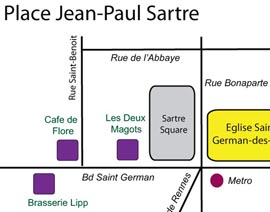
Click here for a bigger map. - How about French intellectuals? They also did their best by "thinking and
writing."
But, in order to think, they had to talk with others. The traditional
meeting place consisted of two French cafes called "Cafe de Flore" and
"Les Deux Magots" near the intersection of on Bd Saint-German (east-west)
and Rue Bonaparte (north-south). Among those thinking people, Jean-Paul
Sartre was most popular among the young people. He was respected for
providing visions for them.
In Paris maps, this area is called "Place Saint-German-des-Pres." In 2000, the city of Paris decided to give an additional name. Th new name is "Place Jean-Paul Sartre," but you cannot see this new name on paris maps. The new map should look like this.
There is an empty space between Rue Bonaparte and Les Deux Magots, as indicated in my map. I choose to call this area "Sartre Square." Many interesting events take place on this square.
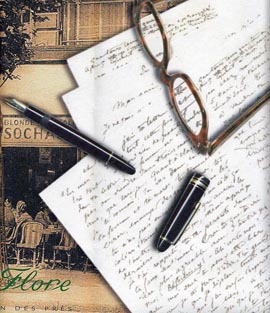
Table sheet at the Cafe de Flore. - During the war, there was a young man living with his mother.
To the mother, her son was everything. Thus, he had to stay home.
On the other hand, this young man strongly felt that he had to fight
for his country, and the only way was to flee to England and join the
French Liberation Army. If he leaves for England, his mother would
lose everything. What should he do? He could not make his decision,
and went to Sartre for his advice. Sartre said
-
You have two excellent choices.
You are free to choose. - This is not your first time to hear this Sartre story. Yet, it is quoted
often. It is like some Bible stories. For instance, Nicodemus was a
Pharisee (Jewish upper-class man), and he had troubles with himself and
with his environment. He went to Jesus and asked him what he should do.
He got a totally un-expected answer. This story is in the Gospel of John.
I quote this Nicodemus story often in my conference talks, and
this is my story.
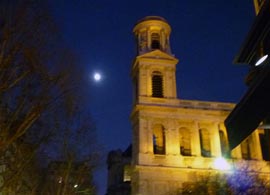
-
Moonlight on Eglise Saint-Sulpice,
500 meters south of the Sartre Square. Like this moon, you are alone when you make your choices. - Why is this Sartre story so important to physicists? The answer is very
simple. If you are a young physicist, your post-doc world is like Paris under German
occupation. Indeed, your job is make your own excellent choices.
If you are an old physicist like myself, you would like to tell others how happy you are for having made your own choices. I of course would love to talk about my experiences, but let me refrain myself. The only story I could tell you is that I have been publishing my papers for more than fifty years, but I spent at least 20 years in humiliation (like Parisians during World War II). I was able to hide those humiliations with my publication list. This is the reason why I mentioned above Marcel Carne's film "Children of Paradise." I am telling you this story because it could be yours too. Open this webpage for your entertainment.
Let us stop the serious talk. The best way to appreciate Jean-Paul Sartre is to spend a few days at the Place Jean-Paul Sartre. I was fortunate enough to stay four nights during the second week of January (2012) at a hotel in that area. I would like to share with you some of the photos I took there.
- This hotel manager was born
in this area, and saw Sartre walking around. She heard that he was a famous
philosopher, but she was too young to ask questions to ask him. She was afraid
of him.
Jean-Paul Sartre used to spend his times at the Cafe de Flore and Les Deux Magots. He was thinking and writing when he was alone. He was talking when he was with young people in these two cafes.
- Two Sartre Cafes during
the Christmas season. Cafe de Flore on left, and Les Deux Magots on right.
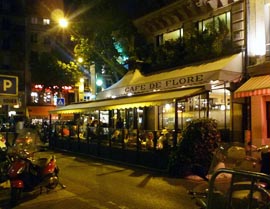
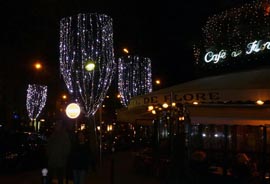
- Cafe de Flore. I was there in 1995,
and went there many times since then.
- During evening hours, the cafe is busy and lively. Seen from Bd Saint-German.
- Seen from Rue Saint-Benoit, which is perpendicular to Bd Saint-German. I staid in a hotel about 50 meters north along this street.
- Cafe de Flore during the Christmas season. Street trees were converted to wine glasses.
- Sidewalk open space.
People like fresh air, and talk freely. I talked to
these French ladies.
They are all cheerful Parisians.
- Sartre's pen, glasses, his handwriting from one of the table sheet.
- Souvenirs from old days. There are many items on the second floor.
- Sartre's French money. I
still have some old French coins and show them off to young people whenever I go to
France.
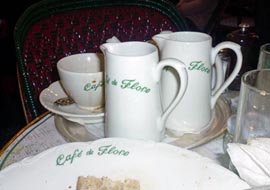
Breakfast set at Cafe de Flore. - Sunday Breakfast was also
an unforgettable experience.
- Grandmother and granddaughter sitting in front of me. I asked them why they look so identical. They told me to ask God. They came from Lyon.
- This senior lady was sitting next to me. She came with a young man, and I asked her whether he is her grandson. She said No. He was her chauffeur. She lives in Geneva, but comes to Paris often to see the real world. It is safe to assume that she is a very rich lady.
- Another lady came after the Swiss lady left. She lives in Paris, and comes to this Cafe every Sunday morning. She said she can find a parking spot only on Sunday mornings. She also had a very interesting life style.
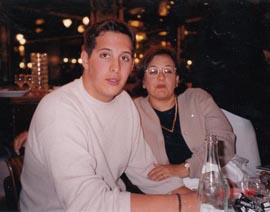
-
Mexican mother and son.
A woman looks beautiful with her son, as we see in Catholic churches. - Brasserie Lipp is on the
opposite side of Bd Saint-German. Ernest Hemingway used come here
very often.
- This cafe has an elegant interior dining room. I was able to see why Hemingway liked this place.
- In 1998, I met there this beautiful set of Mexican mother and son. The mother was highly educated and was familiar with the academic world. When I mentioned the Herod Complex, she clearly understood what I meant. It is always a pleasure to meet interesting people in Paris.
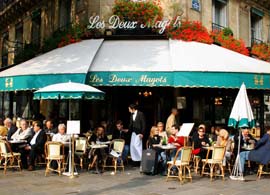
Les Deux Magots was also Sartre's favorite cafe.
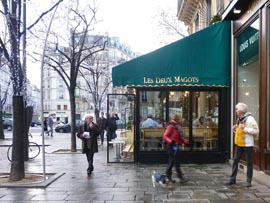
-
During the summer, the out-door section of this cafe extends itself toward Rue
Bonaparte, as shown here.
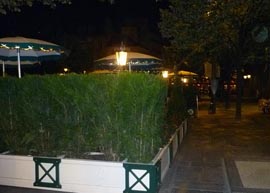
- Les Deux Magots was also
Sartre's favorite place. I was there also in 1995 to have this photo. I go there
whenever I am in Paris to meet interesting people.
- From Luxemburg. I met these ladies during the breakfast hour (January 2012). They said they came here for business. What business? I asked them. They said "Shopping." If you think deeply, shopping is a very important business for everybody. During the first two weeks of every year, Paris shops offer deep discounts for most of their items to reduce their inventories accumulated for the year-end holiday season.
- During the fall season, Les Deux Magots looks like this. People prefer sitting outside in spite of chilly temperature.
- During the winter time, the restaurant looks like this with a glass-enclosed outside space. This photo was taken during the breakfast time.
- During the summer time, Les Deux Magots extends its business area to the Sartre Square (open space toward Rue Bonaparte).
- Under one of those umbrellas, I dined. I met a Russian lady with her German business partners. She told me she came from Moscow. I then asked whether she came from Yasanevo, and she said Yes. She became so happy, and we had this photo. She asked me how I knew, and I said I simply know by looking at her. However, in truth, I did my scientistic calculation. The are 10 million people in Moscow, and about one half million of them live in the residential area called Yasanevo, south of Moscow. Therefore, the probability of my being right is 5 percent. I enjoy being in Paris, because I am free to think.
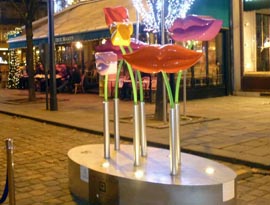
- Sartre Square. The open
space between Les Deux Magots and Rue Bonaparte could be called the Sartre Square.
Many interesting events take place.
- Sartre Square in the morning. Unlit Christmas lights are on the trees.
- Rue Bonaparte and Rue de Rennes seen from the Square. The Montparnasse Tower is at the end of Rue de Rennes.
- Lighted Lips in front of Les Deux Magots.
- With those lips, how do I look? These lips stayed there for only one night. They were gone next night.
- Roasted chestnuts in nine
different languages, telling that the Square is an international arena.
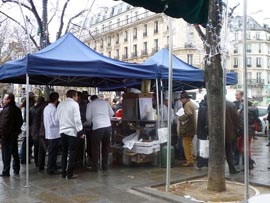
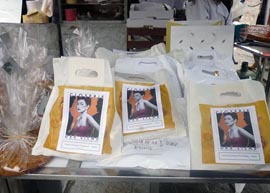
- Food fair in the morning before the sun rise.
- Food fair continued throughout the morning hours.
- French chefs who came to
the Square to show off their creative talents.
- One of those chefs, I had a photo with.
- She was very proud of her position.
- Let us look at where she works.
- Breakfast packages prepared
by La Closerie des Lilas, located at the intersection of Bd Saint-Michel and Bd.
Montparnasse, 2 kilometers south-east of the Sartre Square. This cafe is used to
be a meeting place for many famous writers including Ernest Hemingway of the
United States. I was there four times since 1995, and had
this photo there in January of 2012. The poster says "Cafe de Flore." Am I at a wrong place? No. The same owner owns both Cafe de Flore and La Closerie Lilas.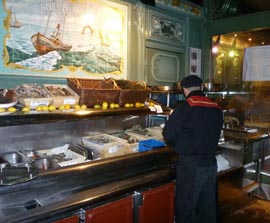
- This seafood restaurant is one of the many eat/drink places along Rue de l'Abbaye (Church Street), which serves as the northern boundary of the Sartre Square.
- Fresh seafood being prepared outside the dining room. This portion of the kitchen is on the street.
- Le Relais de l'Entrecote is another popular restaurant one block north of the Cafe de Flore along Rue Saint-Benoit. The restaurant is always crowded because the menu items are moderately priced. I could not get in because I did not want to wait (photo from the public domain).
- Le Relais de l'Entrecote
seen from the Sartre Square through Rue de l'Abbaye.
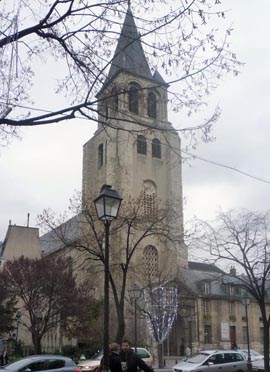
- Eglise Saint-German-des-Pres
on the other side of Rue Bonaparte. This church defines the name of this
area. The metro station is names after this church. To many people, this area
known as the "Place Jean-Paul Sartre," but Parisians cannot defy their history.
- Church Tower. The church building is in good shape. This tower presumably was rebuilt several times since its original construction.
- Inside the Church. The worship places are OK, but the church needs a major renovation.
- The church organ has its unique design, but it looks very old. It needs to be reconditioned.
- Donation needed. This church needs for its reconstruction. This appeal is in English and in Japanese.
- This church has a long history dating back to the 6th century. This is the reason why this area cannot be easily renamed as the Place Jean-Paul Sartre, even though Sartre is so dear to modern French citizens.


- Sartre's Tomb is the
Montparnasse Cemetery in Paris. I was there in April of 2012.
- The Cemetery is near the Montparnasse Tower about one kilometer south of the Sartre Square. This photo was taken from the top of the Tower.
- The Montparnasse Tower seen from the top of the Arch of Triumph. This tall building is one of the landmarks in Paris. The building with the golden also seen in this photo houses Napoleon's gasket.
- The Tower seen from the nearby ground.
- Another View from
the Jean-Paul Sartre Square through Rue de Rennes.
- Henri Poincare was buried in his family tomb. His name can be seen here. Many people came here and left Paris metro tickets as souvenirs.
- Guy de Maupassant's tomb is also in this cemetery.
- The most important person in this cemetery. She has her life. I met this young lady from Australia, and I became very happy, and she felt in the same way toward me.
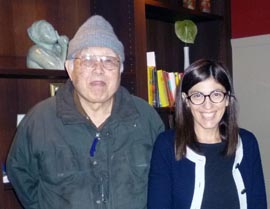
|
|
Other photos from Paris?
- Champ-Elysees (July 14, 1996) with
military parades. 11 photos.
- Champ-Elysees (January 12, 2012)
with Christmas lights. 12 photos.
- Paris and other places in France
- copyright@2012 by Y. S. Kim, unless otherwise specified.
- Click here for his home page.
- Einstein page.
- Princeton page.
- Travel page.
- Click here for his home page.

|
|
How is this man
entangled with Einstein? |